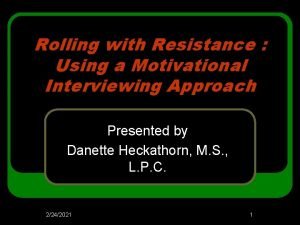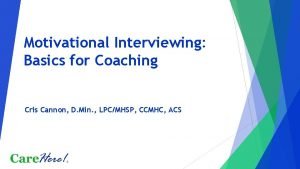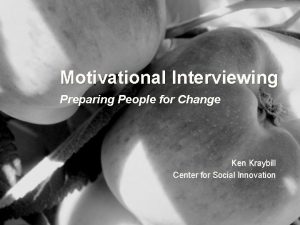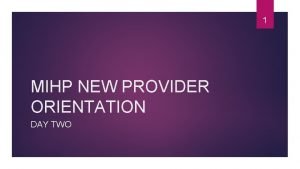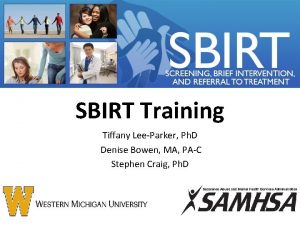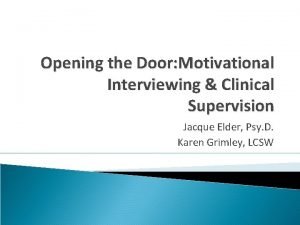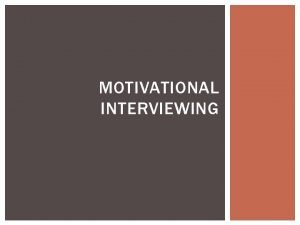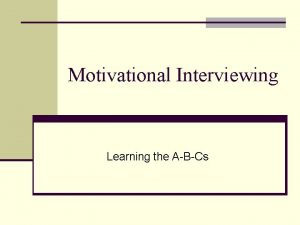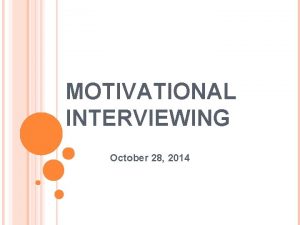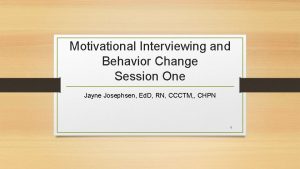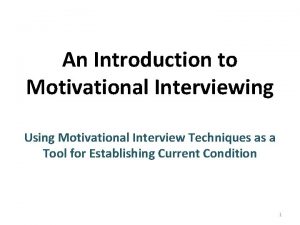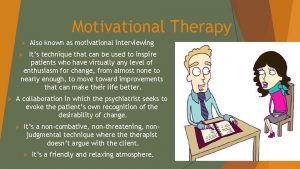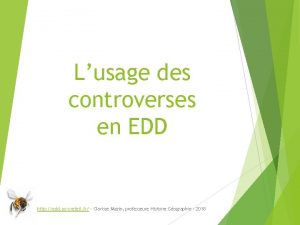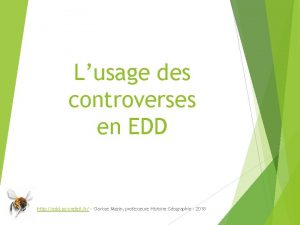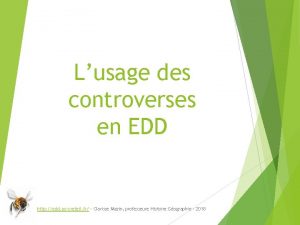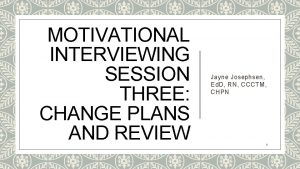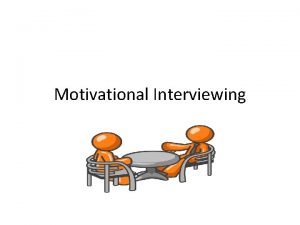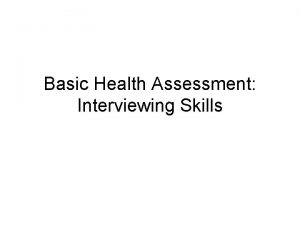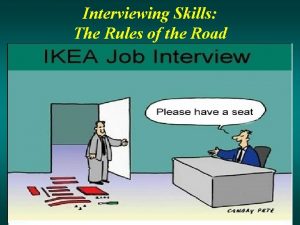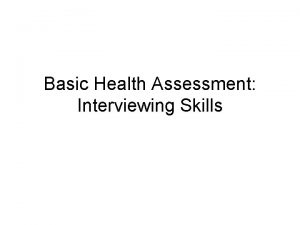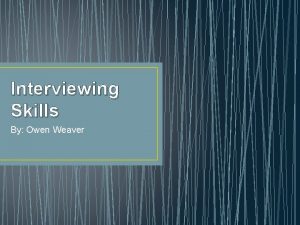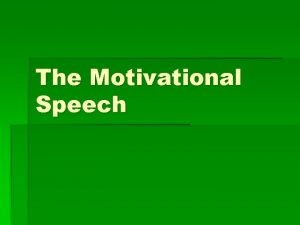MOTIVATIONAL INTERVIEWING SKILLS SESSION TWO JAYNE JOSEPHSEN EDD






























- Slides: 30

MOTIVATIONAL INTERVIEWING SKILLS SESSION TWO JAYNE JOSEPHSEN, EDD, RN, CHSE, CHPN 1

OBJECTIVES Understand the role of activation and readiness in change Respond to change and sustain talk Explore communication techniques used in MI to help clients explore readiness to change and engage in their health 2

HOMEWORK/CASE STUDY REVIEW QUESTIONS, COMMENTS, REFLECTIONS DECISIONAL WORKSHEET RESPONDING TO KAREN 3

ACTIVATION/EMPOWERMENT READINESS/CONFIDENCE ASSESSMENTS AND TECHNIQUES

WAYS TO PROMOTE ENGAGEMENT Start with a common ground-start from a place of mutual agreement and understanding Highlight opportunities for progress. Positive message work better than negative messages Offer immediate rewards. Identify immediate positive consequences of a behavior change Expand agency -We ask people to give up a behavior which the person can interpret as lack of control Consider mental state. Assess stressors and responsibilities and address these

THE PATIENT ACTIVATION MEASURE SCALE 6

MOVING FORWARD FOR EMPOWERMENT Informing Consulting Involving Collaborating Empowering Informingprovide balanced and objective information to assist in understanding Consultingobtain feedback from the person concerning decisions Involvingworking directly with the person throughout the process to ensure all concerns and goals are understood and addressed Collaborating. Partner with the person in each aspect of decisionmaking including development of alternatives and solution Empowering. Ensure the person has the ultimate control over the decisions that affect their well being and life

READINESS ASSESSMENT 8

IMPORTANCE RULER EXERCISE Importance Ruler What behavior is the focus of change? 1 -10 how important is it to you to make this change right now? Follow-up questions for ranking What puts you at that number What would it take to move up one number If importance is low When do you see this changing? What things will you watch for to know when the time has come to change? 9

CONFIDENCE RULER EXERCISE Confidence Ruler 1 -10 how confident are you that you can make this change right now? Follow up questions What puts you at that number? What would it take to move up a number? If confidence is low Explore ways to build confidence When you have made a change like this in the past what did you draw on in terms of personal qualities and support? 10

SUSTAIN VS. CHANGE TALK

CHANGE TALK- DARN CAT Self-talk that envisions change and expresses an argument for change The client considers the pros and cons of a change Preparatory Change Mobilizing Change Commitment- “I have good reasons to…” Desire- “ I want to lose some weight” Activation- “I am willing to…” Ability- “ I would be able to…” Taking Steps- “ This week I skipped Reasons- “I would have more dessert” energy” Need- “I can’t keep going on like this” 12

RESPONDING TO CHANGE TALK DARN Desires: Problem Recognition What difficulties have you had in relation to your smoking? Ability: Optimism About Change Can you describe a successful change you have made in the past? Reasons: Concerns About the Behavior What do you think will happen if you do not lose weight? Needs: Commitment to Change How might your life be different if you made these changes? CAT Commitment: Eliciting Intention What do you intend to do? Activation: Eliciting Plan What are you willing to do? Taking Steps: Eliciting Implementation What have you already done? 13

BARRIERS TO CHANGE TALK Pattern of questions and answers between provider and client-use the OARS instead The provider promotes change before the client has resolved ambivalence-can lead to denial and confrontation The provider promotes change without first guiding the client to identify their needs and goals- can lead to a client less committed to change The provider labels the client as “non-compliant” or some other label-can lead to client feeling shamed or judged-not patient-centered The provider focuses on their agenda rather than the client’s agenda-can lead to client disengaging from the process 14

SUSTAIN TALK DARN Desires- “ I like to eat what I want” Ability- “I think my health is fine without changing …” Reasons- “I relax when I smoke” Need- “I just need to accept this is how I CAT Commitment- “I have had it with trying diets” Activation- “I am just not ready to change” Taking Steps- “ I threw away my food journal” am” 15

RESPONDING TO SUSTAIN TALK Sustain talk is a sign that the provider’s tactics do not match the clients state of change Use OARS to help the client clarify their perspective on the behavior and facilitate change Reframing: Take the arguments against change and alter the meaning of the information to promote change Example: You have already been making an effort to cut back on your smoking, realizing its importance Amplified reflection: acknowledge the clients statement but in an extreme manner (non- sarcastically) Example: “The way you see it the situation cannot be changed at all” Double sided reflection Example: “On the one hand you are aware that quitting smoking will mean you will need to 16 keep on top of your diet also and you are wondering if it is now worth the effort”

RESPONDING TO CLIENT RESISTANCE Responses to Resistance can include Shift the focus of the conversation Arguing Reframe and offer another perspective Denying Emphasize the client’s responsibility in Interrupting Not Responding Blaming their personal choices Support the client’s ability to change Use reflective responses to give the client the ability to clarify 17

COMMUNICATION TECHNIQUES IN MOTIVATIONAL INTERVIEWING

OARS TOOL Open ended questions These elicit the clients perspective. They cannot be answered with a yes or no or with a short response What are some open ended questions you use with your clients? Affirmation This communicates that the provider understands the client’s struggles. Affirmation build on client strengths Best used when focusing on something the client has done or has said What are some affirmative statements you use with your clients? Reflective listening This confirms what the client means Can also be used to direct change talk by reflecting emotions that can be motivating Simple reflection repeats the statements or uses similar words Complex reflection includes paraphrasing, summarizing, affirming, and using metaphors Summary The provider summarizes the client’s concerns, goals, action plans, and also affirms and encourages positive change 19 Mini-summaries throughout the meeting with the client can be helpful

REFLECTIVE LISTENING-WHAT IS THIS? Making a guess of what the person is meaning Listening involves decoding meaning Reflective listening involves forming a reasonable guess as to what the original meaning is and gives voice to that in the form of a statement or question Reflections can be simple or complex Reflective listening maintains that clients are experts on themselves and can reach their own conclusions and decisions It closes the circle of communication-but if you keep going around in circles in the conversation you are probably being too simple in your reflections 20

REFLECTIVE LISTENING TIPS Reflective stems Barriers to reflective listening What I heard you say… Arguing Sounds like. . . Ordering You’re feeling like. . . Threatening For you, it is a matter of. . . Kidding Your concern is. . . Agreeing Your fear is that. . . Avoiding It’s really important to you that. . . Moralizing It seems to you, so you. . . Interrogating 21

BRIEF MOTIVATIONAL INTERVIEWING AGENDA SETTING & ELICIT PROVIDE ELICIT 22

BRIEF MI ELICIT/PROVIDE/ELICIT AND AGENDA SETTING Ask permission “Would it be alright to have a quick chat about your goals in relation to your diabetes? ” Encourage the client to set the agenda “There are several things we could talk about today, what is it that you would like to talk about? ” Exchange information with Elicit/Provide Elicit: So how much do you know about the complication of diabetes? Provide: Would it be ok if I told you a little bit more? Elicit: So, what do you think that might mean for you and your diabetes? 23

MASON AND BUTLER AGENDA SETTING CHART 24

HOMEWORK BRIEF MI AGENDA SETTING AND PROVIDING INFORMATION (ELICIT-PROVIDE-ELICIT) 25

HOMEWORK ACTIVITY When meeting with a client practice agenda setting Ask the client permission to discuss an area of change Encourage the client to set the agenda Use the agenda setting chart provided Exchange information with the client using the elicit-provide-elicit method Reflect upon how this type of delivery of information was different or more advantageous than how you have delivered information in the past. 26

AGENDA SETTING BUBBLE CHART 27

CAREGIVER CASE STUDY

WHAT ARE SOME WAYS IN WHICH YOU MIGHT HELP THE CAREGIVERS ADDRESS THEIR CAREGIVING ISSUES USING MI? Jean (75) takes of Ray (80) at home, with the help of two of her four children after Ray had a stroke. Ray becomes verbally abusive when immobility, incontinence, noisy grandchildren, and other irritations frustrate him. Jean says she would be very guilty about having to send Ray to a facility, as her own mother cared for her father when he became frail and infirm. Ray and Jean’s youngest child has struggled with addiction to drugs and is serving a jail term for possession of cocaine. Because of this, Jean and Ray have been the primary caregivers for their grandson Jason for several years. Recently Jason has been sneaking out of the house and was arrested for shoplifting. Their daughter, Miranda, is concerned that Jean can no longer meet the needs of her husband grandson and is not attending to her own physical and mental health. Miranda cannot get time off work regularly to assist, and when she does, she becomes irritated with Ray as he is verbally abusive to Jean, Jason, and herself. ADAPTED FROM: HTTPS: //POGOE. ORG/PRODUCTID/21817

QUESTIONS? NEXT SESSION: GOAL SETTING, BRIEF ACTION PLANNING, REVIEW 30
 Agreement with a twist motivational interviewing examples
Agreement with a twist motivational interviewing examples Motivational interviewing
Motivational interviewing Dears motivational interviewing
Dears motivational interviewing Motivational interviewing schizophrenia
Motivational interviewing schizophrenia Cris cannon
Cris cannon Motivational interviewing dears
Motivational interviewing dears Preparatory change talk examples
Preparatory change talk examples Motivational interviewing stages of change
Motivational interviewing stages of change German motivational speech
German motivational speech Motivational interviewing
Motivational interviewing Decisional balance
Decisional balance Agreement with a twist motivational interviewing
Agreement with a twist motivational interviewing Readiness ruler motivational interviewing
Readiness ruler motivational interviewing Motivational interviewing
Motivational interviewing Darn cats motivational interviewing
Darn cats motivational interviewing Dares motivational interviewing
Dares motivational interviewing Stages of change in social work
Stages of change in social work Darn cat motivational interviewing
Darn cat motivational interviewing Motivational interviewing
Motivational interviewing Agreement with a twist motivational interviewing
Agreement with a twist motivational interviewing Sbirt faith and spirituality
Sbirt faith and spirituality Darn cat motivational interviewing
Darn cat motivational interviewing Motivational interviewing
Motivational interviewing Darn cat motivational interviewing
Darn cat motivational interviewing Agenda mapping bubble sheet
Agenda mapping bubble sheet Motivational interviewing traps
Motivational interviewing traps Motivational interviewing wiki
Motivational interviewing wiki Jayne van bramer
Jayne van bramer Disney company hierarchy
Disney company hierarchy Jayne grandes
Jayne grandes Isabelle duchesnay
Isabelle duchesnay
